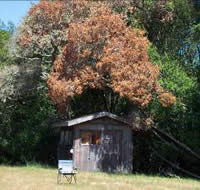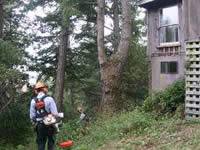
National Fire Plan Success Story
Work of Fire Season Begins with Defensible Space
Point Reyes National Seashore, California
National Fire Plan - Fuels Reduction

Tree infected with Sudden Oak Death. NPS photo by Marissa Spata.

Fuels crew creating defensible space around a park housing unit. NPS photo by Patricia Gerrity.
JUNE 7, 2007 - The first project the fire crew tackles each year at Point Reyes National Seashore is to create defensible space around park structures to reduce the threat wildfire. Defensible space is the space between a structure and surrounding vegetation which makes it possible for firefighters to safely defend a structure, and may also allow a structure to survive on its own. Defensible space within the park is a shared responsibility involving fire and roads staff as well as housing tenants.
There are 55 government housing units which make up the majority of this work. Year round employees who occupy these housing units are responsible for mowing lawns and trimming shrubs within 30 feet of the structure and 10 feet around propane tanks. Woodpiles must also be located at least 30 feet from all structures. Grass and weeds near structures must be cut and pulled all summer long as the fog along the coast keeps vegetation growing even during the hot, dry months. Several housing units are on historic ranches which have numerous other outbuildings needing defensible space as well.
When access allows, the roads crew uses a tractor mower to cut grass around these buildings. The fire crew is responsible for removing low hanging branches and cutting back overgrown shrubs which create dangerous ladder fuels that could carry a wildfire toward structures. The fire crew also removes dead trees and branches which pose a fire hazard resulting from storm damage or disease. This workload has the potential to increase greatly in the coming years with the occurrence of Sudden Oak Death being on the rise. Sudden Oak Death is a disease resulting from a non-native, fungus-like pathogen, Phytopthera ramorum, which was first observed in Marin County in 1995, and has been gradually spreading toward National Park Service lands on the coast. Increasing numbers of tanoaks and coast live oaks in the park are dying as their trunks become infected.
Several historic structures which serve as administrative buildings are also part of the routine defensible space work at the beginning of fire season. The Pacific Coast Learning Center which supports visiting researchers, operates out of a historic house which was part of the former Hagmaier Ranch. The historic RCA building in the north district of the park, is the operations center for the California Exotic Plant Management Team, the Central and Southern California Fire Effects Monitoring Crew, and the Point Reyes Sign Shop. Valuable equipment, data and field records could be lost if these structures burned.
Defensible space requirements in California have increased from a minimum of 30 feet to 100 feet as a result of the devastating 2003 wildfires in southern California. California Department of Forestry and Fire Protection guidelines emphasize a "lean, clean, and green" zone for the first 30 feet around structures, followed by a "reduced fuel" thinning zone in the next 70 feet. Property owners are responsible for the defensible space around their structures. Tenants may be responsible for this work if it is part of their rental agreement.
Contact: Roger Wong, Fire Management Officer
Phone: (415) 464-5232